英语经贸知识总结
- 格式:docx
- 大小:29.43 KB
- 文档页数:12
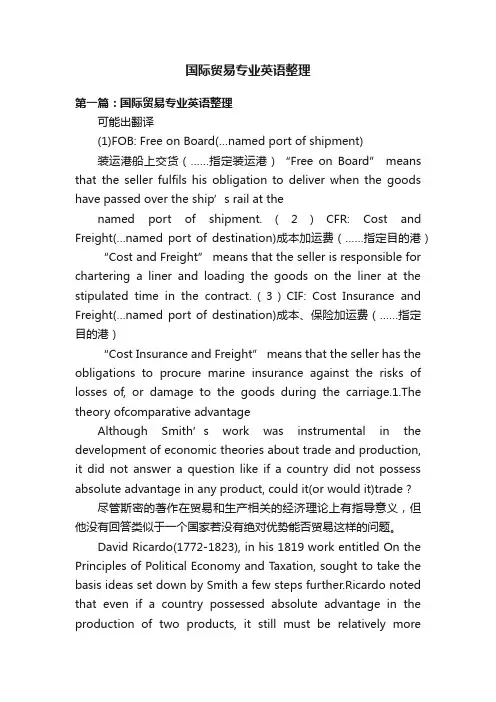
国际贸易专业英语整理第一篇:国际贸易专业英语整理可能出翻译(1)FOB: Free on Board(…named port of shipment)装运港船上交货(……指定装运港)“Free on Board” means that the seller fulfils his obligation to deliver when the goods have passed over the ship’s rail at thenamed port of shipment.(2)CFR: Cost and Freight(…named port of destination)成本加运费(……指定目的港)“Cost and Freight” means that the seller is responsible for chartering a liner and loading the goods on the liner at the stipulated time in the contract.(3)CIF: Cost Insurance and Freight(…named port of destination)成本、保险加运费(……指定目的港)“Cost Insurance and Freight” means that the seller has the obligations to procure marine insurance against the risks of losses of, or damage to the goods during the carriage.1.The theory ofcomparative advantageAlthough Smith’s work was instrumental in the development of economic theories about trade and production, it did not answer a question like if a country did not possess absolute advantage in any product, could it(or would it)trade ?尽管斯密的著作在贸易和生产相关的经济理论上有指导意义,但他没有回答类似于一个国家若没有绝对优势能否贸易这样的问题。
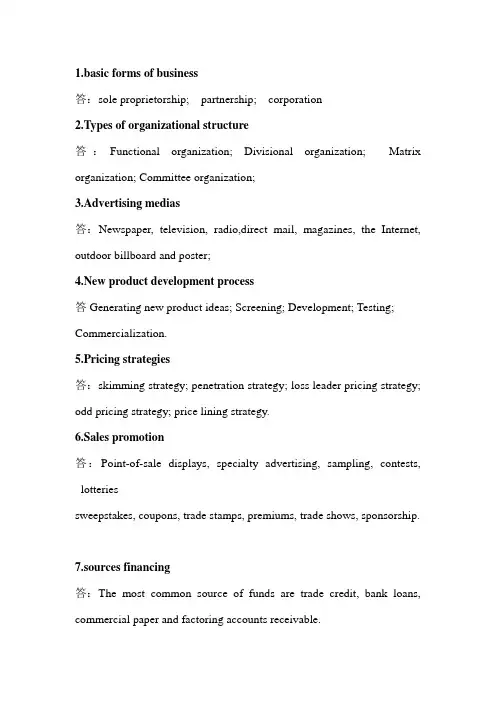
1.basic forms of business答:sole proprietorship; partnership; corporation2.Types of organizational structure答:Functional organization; Divisional organization; Matrix organization; Committee organization;3.Advertising medias答:Newspaper, television, radio,direct mail, magazines, the Internet, outdoor billboard and poster;4.New product development process答Generating new product ideas; Screening; Development; Testing; Commercialization.5.Pricing strategies答:skimming strategy; penetration strategy; loss leader pricing strategy; odd pricing strategy; price lining strategy.6.Sales promotion答:Point-of-sale displays, specialty advertising, sampling, contests, lotteriessweepstakes, coupons, trade stamps, premiums, trade shows, sponsorship.7.sources financing答:The most common source of funds are trade credit, bank loans, commercial paper and factoring accounts receivable.8.items in a balance sheet答:A balance sheet is made up of three types of accounts, i.e. assets, liabilities and owners’ equity;Assets: cash, accounts, receivable, inventory, investments in other business, land,equipment, buildings, vehicle, patents, copyrights, etc.Liabilities: short-term or current liabilities and long-term liabilities. Owners’ equity=assets minus liabilities, For sole proprietor, it means the value ofEverything owned; for corporation, it means capital stock.9.challenges of international trade答:Social and cultural differences; foreign exchange, trade barriers; tariffs;Non-tariff barriers.10.Maslow’ s hierarchy of human needs答:Abraham Maslow was the first researcher to identify human needs systemtically and rank them in a hierarchy;From bottom to top are physiological needs, Security needs, social needs, esteem needs, self-actualization needs.Maslow’s hierarchy has been accepted as the most comprehensive theory ofHuman needs ever proposal and is widely used by managers inmotivating theirEmployees.1.Function of marketing:marketing research; acquiring; selling; transportation; storaging; finance and credit; risk taking; standardization and grading2.marketing mix:Product; price; promotion; place3.market segmentation:Geographic variables; demographic variables; psychographic variable; product-use variables.4.nonprice strategies:Add value; Educate customers; Establish Relationships.5.Retailers:Department stores; discount stores; supermarkets; hypermarket; general stores; specialty stores;Other retailing businesses:Virtual stores; vending machines; mail-order houses; direct selling; cart and kiosks; multilevel marketing6.The cost and value of intermediaries:Time utility; place utility; ownership utility; form utility; informationutility; service utility.7. personal selling process:Prospect; qualify; approach; make presentation; handle objections; close; follow-up.8.Management function:Planing; organizing; leading; controlling9.strategies for motivating employees:Rewards and punishment; management by objectives(MBO); participative management; make jobs more satisfying and motivating; modified work schedules;2011/12《经贸英语选读》复习指南:Part I. Multiple-Choice Questions 答题卡上(共40题,每题1分)There are two types of exercises: One type is to test your memory of the basic concepts learned in the text book; the other type is the understanding and use of concepts in case study.Examples:When a business’s revenues exceed its expenses, it has created ____.A.ProfitsB.SalesC.LossespetitionWhich of the following is not true about promotional methods for marketing:A.Businesses use them to communicate informationB.They replace exchange relationship with customers.C.They seek to persuade people to purchase productsD.They are intended to make products more attractive. Procter and Gamble has Baby Care, Beauty Care, Health Care, and Home and Fabric Care divisions in its US operations. This is an example ofA.geographic departmentalization.B.process departmentalizationC.maintenance departmentalization.D.product departmentalization.Part II. Reading Comprehension(共12题,每题2分)3 passagesPart III. Filling in the blanks. (共10题,每题1分)Part IV. Questions(共4题,每题4分)key concepts:basic forms of business(unit 1)Types of organizational structure (unit 13/136p Advertising medias (5/ 43pNew product development process(3/22ppricing strategies(3/23pSales promotion(5/46psources financing (7/63-68pitems in a balance sheet(8/73-75pchallenges of international trade(12/120p以后Maslow’ s hierarchy of human needs(15/158pPart IV. Writing(共1题,10分)About150 wordsA topic is given.重点章节12 15 13 1 2 3 4 5。
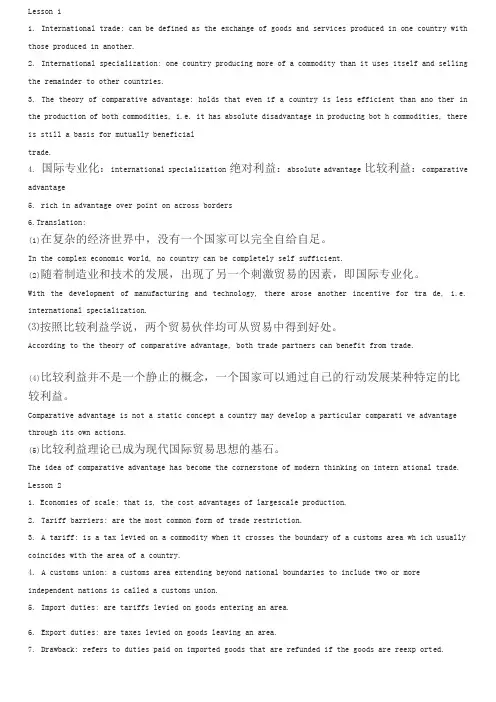
Lesson 11.International trade: can be defined as the exchange of goods and services produced in one country withthose produced in another.2.International specialization: one country producing more of a commodity than it uses itself and sellingthe remainder to other countries.3.The theory of comparative advantage: holds that even if a country is less efficient than ano ther inthe production of both commodities, i.e. it has absolute disadvantage in producing bot h commodities, thereis still a basis for mutually beneficialtrade.4.国际专业化:international specialization 绝对利益:absolute advantage 比较利益:comparative advantage5.rich in advantage over point on across borders6.Translation:(1)在复杂的经济世界中,没有一个国家可以完全自给自足。
In the complex economic world, no country can be completely self sufficient.(2)随着制造业和技术的发展,出现了另一个刺激贸易的因素,即国际专业化。
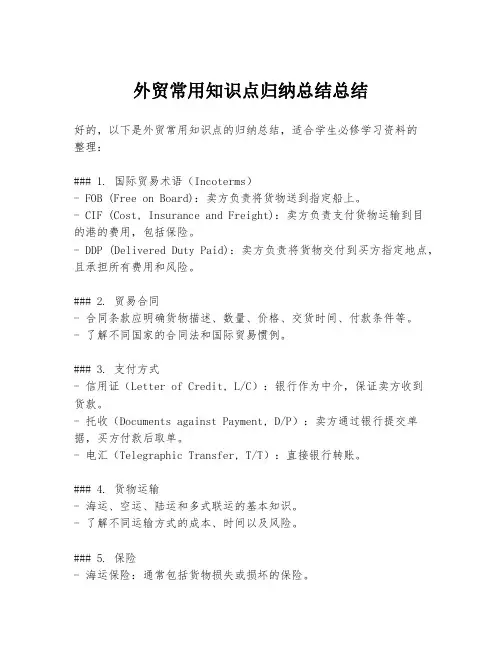
外贸常用知识点归纳总结总结好的,以下是外贸常用知识点的归纳总结,适合学生必修学习资料的整理:### 1. 国际贸易术语(Incoterms)- FOB (Free on Board):卖方负责将货物送到指定船上。
- CIF (Cost, Insurance and Freight):卖方负责支付货物运输到目的港的费用,包括保险。
- DDP (Delivered Duty Paid):卖方负责将货物交付到买方指定地点,且承担所有费用和风险。
### 2. 贸易合同- 合同条款应明确货物描述、数量、价格、交货时间、付款条件等。
- 了解不同国家的合同法和国际贸易惯例。
### 3. 支付方式- 信用证(Letter of Credit, L/C):银行作为中介,保证卖方收到货款。
- 托收(Documents against Payment, D/P):卖方通过银行提交单据,买方付款后取单。
- 电汇(Telegraphic Transfer, T/T):直接银行转账。
### 4. 货物运输- 海运、空运、陆运和多式联运的基本知识。
- 了解不同运输方式的成本、时间以及风险。
### 5. 保险- 海运保险:通常包括货物损失或损坏的保险。
- 信用保险:保护卖方免受买方违约的风险。
### 6. 贸易壁垒- 关税、配额、许可证等贸易保护措施。
- 了解WTO规则和区域贸易协定。
### 7. 外汇管理- 汇率变动对贸易的影响。
- 外汇风险管理策略。
### 8. 贸易法规与合规- 了解出口国和目的国的贸易法规。
- 遵守反洗钱、反恐融资等国际合规要求。
### 9. 电子商务与数字贸易- 跨境电商平台的运作模式。
- 数字贸易的法律和税务问题。
### 10. 风险管理- 信用风险、市场风险、操作风险的识别与管理。
### 11. 文化差异与商务礼仪- 不同文化背景下的商务沟通技巧。
- 国际商务礼仪和习俗。
### 12. 国际市场营销- 了解目标市场的需求和偏好。
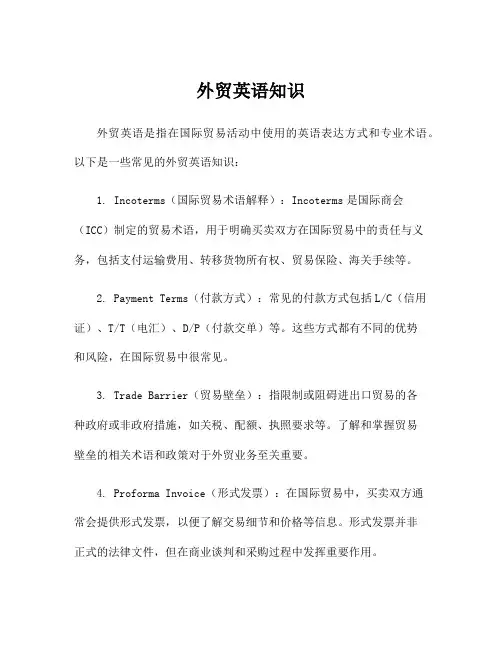
外贸英语知识
外贸英语是指在国际贸易活动中使用的英语表达方式和专业术语。
以下是一些常见的外贸英语知识:
1. Incoterms(国际贸易术语解释):Incoterms是国际商会(ICC)制定的贸易术语,用于明确买卖双方在国际贸易中的责任与义务,包括支付运输费用、转移货物所有权、贸易保险、海关手续等。
2. Payment Terms(付款方式):常见的付款方式包括L/C(信用证)、T/T(电汇)、D/P(付款交单)等。
这些方式都有不同的优势
和风险,在国际贸易中很常见。
3. Trade Barrier(贸易壁垒):指限制或阻碍进出口贸易的各
种政府或非政府措施,如关税、配额、执照要求等。
了解和掌握贸易
壁垒的相关术语和政策对于外贸业务至关重要。
4. Proforma Invoice(形式发票):在国际贸易中,买卖双方通
常会提供形式发票,以便了解交易细节和价格等信息。
形式发票并非
正式的法律文件,但在商业谈判和采购过程中发挥重要作用。
5. Trade Fair(贸易展会):贸易展会是供供应商和买家进行商业交流和推广产品的重要渠道。
参与贸易展会需要了解相关的展览术语和活动流程。
以上仅是外贸英语知识的一部分,除了常见的词汇和术语外,还包括贸易文件、货物运输、货物保险、国际结算等方面的专业知识。
掌握这些知识可以帮助外贸从业者更好地开展国际贸易活动。
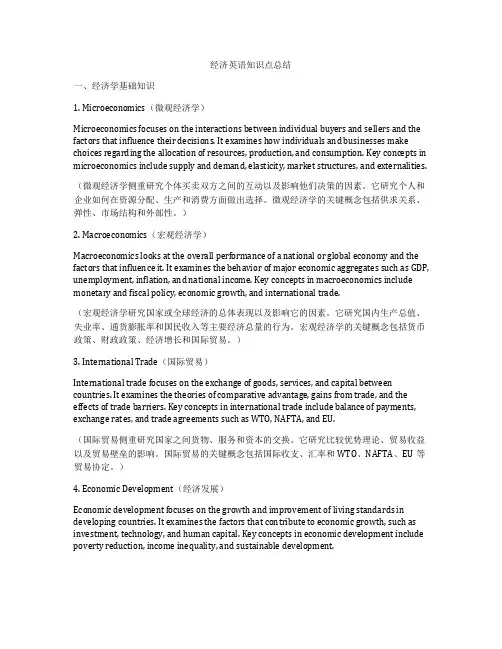
经济英语知识点总结一、经济学基础知识1. Microeconomics(微观经济学)Microeconomics focuses on the interactions between individual buyers and sellers and the factors that influence their decisions. It examines how individuals and businesses make choices regarding the allocation of resources, production, and consumption. Key concepts in microeconomics include supply and demand, elasticity, market structures, and externalities.(微观经济学侧重研究个体买卖双方之间的互动以及影响他们决策的因素。
它研究个人和企业如何在资源分配、生产和消费方面做出选择。
微观经济学的关键概念包括供求关系、弹性、市场结构和外部性。
)2. Macroeconomics(宏观经济学)Macroeconomics looks at the overall performance of a national or global economy and the factors that influence it. It examines the behavior of major economic aggregates such as GDP, unemployment, inflation, and national income. Key concepts in macroeconomics include monetary and fiscal policy, economic growth, and international trade.(宏观经济学研究国家或全球经济的总体表现以及影响它的因素。
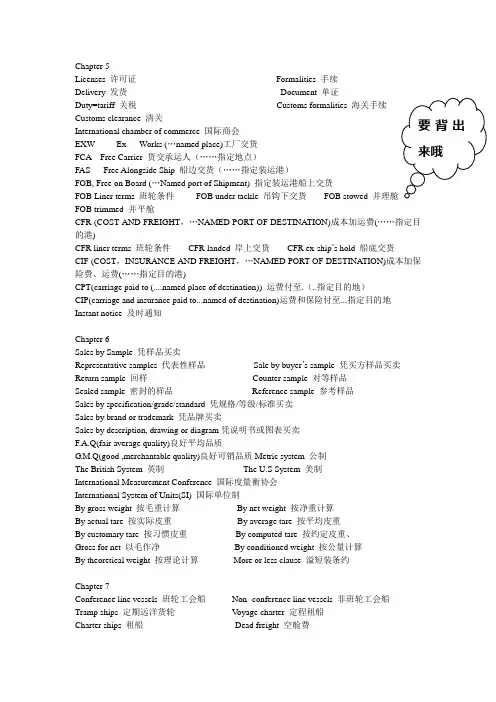
Chapter 5Licenses 许可证 Formalities 手续 Delivery 发货 Document 单证Duty=tariff 关税 Customs formalities 海关手续 Customs clearance 清关International chamber of commerce 国际商会EXW Ex Works (…named place)工厂交货 FCA Free Carrier 货交承运人(……指定地点)FAS --- Free Alongside Ship 船边交货(……指定装运港)FOB, Free on Board (…Named port of Shipment) 指定装运港船上交货FOB Liner terms 班轮条件 FOB under tackle 吊钩下交货 FOB stowed 并理舱 FOB trimmed 并平舱CFR (COST AND FREIGHT ,…NAMED PORT OF DESTINA TION)成本加运费(……指定目的港)CFR liner terms 班轮条件 CFR landed 岸上交货 CFR ex-ship ’s hold 船底交货 CIF (COST ,INSURANCE AND FREIGHT ,…NAMED PORT OF DESTINA TION)成本加保险费、运费(……指定目的港)CPT(carriage paid to (d place of destination)) 运费付至.(..指定目的地)CIP(carriage and insurance paid d of destination)运费和保险付至...指定目的地 Instant notice 及时通知Chapter 6Sales by Sample 凭样品买卖Representative samples 代表性样品 Sale by buyer ’s sample 凭买方样品买卖 Return sample 回样 Counter sample 对等样品 Sealed sample 密封的样品 Reference sample 参考样品 Sales by specification/grade/standard 凭规格/等级/标准买卖 Sales by brand or trademark 凭品牌买卖Sales by description, drawing or diagram 凭说明书或图表买卖 F.A.Q(fair average quality)良好平均品质G .M.Q(good ,merchantable quality)良好可销品质Metric system 公制 The British System 英制 The U.S System 美制 International Measurement Conference 国际度量衡协会 International System of Units(SI) 国际单位制By gross weight 按毛重计算 By net weight 按净重计算 By actual tare 按实际皮重 By average tare 按平均皮重 By customary tare 按习惯皮重 By computed tare 按约定皮重、 Gross for net 以毛作净 By conditioned weight 按公量计算 By theoretical weight 按理论计算 More or less clause 溢短装条约Chapter 7Conference line vessels 班轮工会船 Non- conference line vessels 非班轮工会船 Tramp ships 定期远洋货轮 V oyage charter 定程租船 Charter ships 租船 Dead freight 空舱费要背出来哦Lay days 装卸货时数Demurrage charter 滞期费Dispatch money 速遣费Time charter 定期租船Bare boat charter 光船租船Surcharge 附加运费Bill of lading 提单Chapter 8Insurer 保险人Perils of sea 海上风险The insured 被保险人insurance applicant 投保人Insurance broker 经纪人claimant 索赔者Coverage 险种percentage of addition 投保加成率Extraneous risks 外来风险Natural calamity 自然灾害Fortuitous accident 意外事故General Extraneous risks 一般外来风险Special Extraneous risks 特殊外来风险A verage 海损Total loss 全部损失Actual total loss 实际全损Constructive total loss 推定全损Partial loss 部分损失General average 共同海损Particular average 单独海损Sue and labor expenses 所谓施救费用Salvage charges 救助费用FPA(free from particular average)平安险WPA(with particular average)水渍险All risks 一切险、General additional risks 一般附加险Special additional risks 特殊附加险Additional coverage 附加险Premium 保险费Insurance policy 保单Insurance claim 索赔Insurance amount 保险金额Premium rate 保费率Chapter9Cost of production 生产成本selling and delivery costs 销售运送成本Domestic charges 国内费overseas freight 海运费Customs duties 关税commission 佣金Discount 折扣plain commission 明佣Secret commission 暗佣commission rate 佣金率Net price 净价c-included price 含佣价Unit price 单价total amount 总值Chapter 10Amount of payment 支付金额payment currency 支付货币Depreciate 贬值appreciate 增值Evaluation currency 估价货币convertible currency 可交换的货币Bill of exchange/draft/bill 汇票promissory note 本票Drawer 出票人drawee 受票人Payee 收款人drawing =to issue 出票Endorsement 背书blank endorsement 空白背书Special Endorsement 特别背书Restrictive Endorsement 限定性背书General Endorsement 一般背书finance under bills of exchange 汇票的融资Without recourse 无追索权prior party 前手Conditional endorsement 有条件的背书endorser 背书人Presentment 提示acceptance 承兑Dishonor 拒付recourse 追索Protest 据证书right of recourse 追索权Bona fide holder 合法持有人sight draft 即期汇票Time draft 远期汇票banker’s draft/bank draft 银行汇票Commercial bill/trader’s bill 商业票据documentary bill 跟单汇票Clean bill 光票汇票discounting 贴现Net proceeds 净收入forfeiting 罚金打款Commercial promissory note 商业本票banker’s promissory note 银行本票Checque 支票transfer check 转账支票Crossed check 划线支票remittance 汇付Collection 托付letter of credit 信用证Favorable exchange 顺付adverse exchange 逆付Bank guarantee 银行担保the remitting bank 汇出行The remitter 汇款人the paying bank 汇入行Beneficiary 受益行mail transfer M/T信汇Telegraphic transfer T/T电汇demand draft D/D票汇Open account 赊销payment in advance 预付货款Principal 委托人卖方remitting bank 托收行Collecting bank 代收行the presenting bank 提示行Customer’s representative in case of need 必要时的代理Documents against payment D/P付款交单D/P at sight 即期付款交单D/P at days after sight 见票后几天后付款trust receipt 信托收据Documents against acceptance D/A承兑交单applicant 开证申请人Issuing bank 开证行advising bank 通知银行Revocable documentary credit 可撤销的信用证the irrevocable documentary credit 不可撤销的信用证the confirmed irrevocable documentary credit 保兑不可撤销信用证the negotiation 议付SWIFT 环球同业银行金融电讯协会trade association 贸易联合会Cash check 现金支票notory public 公证机关贸易术语贸易术语主要运费风险转移界限出口报关责任费用谁负担进口报关...运费方式EXW 买方商品所在地(工厂)交货买方处置时买方买方任何方式FCA 买方出口国内地货交承运人处置时卖方买方任何方式FAS 买方装运港货交船边后卖方买方水上运输FOB 买方货物越过装运港船舷卖方买方水上运输CFR 卖方货物越过装运港船舷卖方买方水上运输CIF 卖方货物越过装运港船舷卖方买方水上运输非常重要CPT 卖方出口国内地,港口货交卖方承运处置时卖方买方任何方式CIP 卖方出口国内地,港口货交卖方承运处置时卖方买方任何方式1.EXW (Ex-works…named place——工厂交货……指定地)使用方式:各种运输方式该术语是指卖方在其所在处所(工厂或仓库等)将货物提供给买方时,即履行了交货义务。
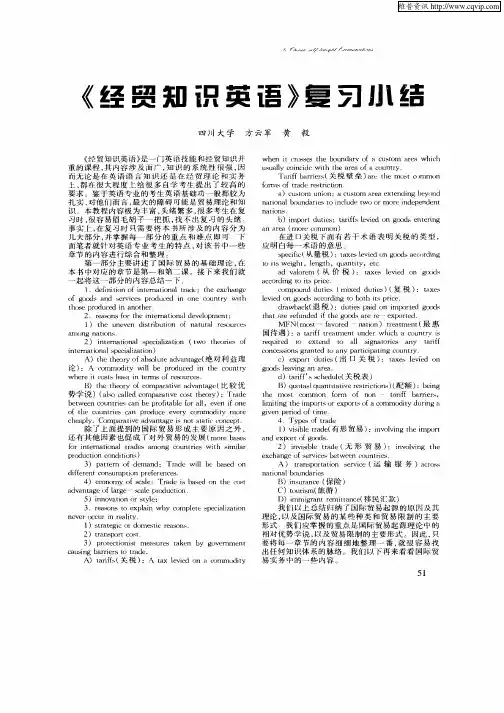
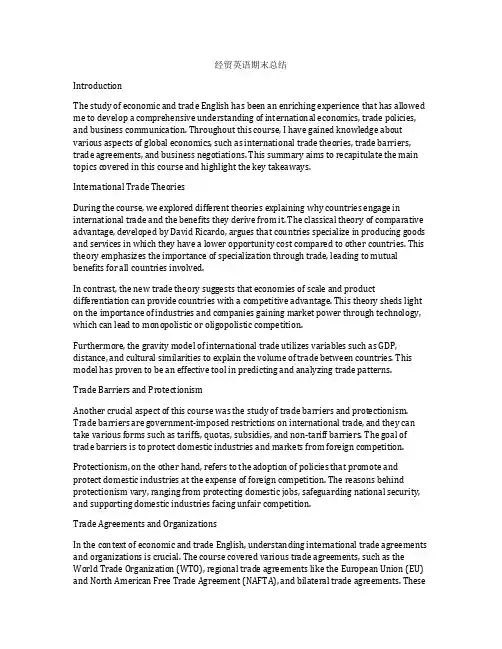
经贸英语期末总结IntroductionThe study of economic and trade English has been an enriching experience that has allowed me to develop a comprehensive understanding of international economics, trade policies, and business communication. Throughout this course, I have gained knowledge about various aspects of global economics, such as international trade theories, trade barriers, trade agreements, and business negotiations. This summary aims to recapitulate the main topics covered in this course and highlight the key takeaways.International Trade TheoriesDuring the course, we explored different theories explaining why countries engage in international trade and the benefits they derive from it. The classical theory of comparative advantage, developed by David Ricardo, argues that countries specialize in producing goods and services in which they have a lower opportunity cost compared to other countries. This theory emphasizes the importance of specialization through trade, leading to mutual benefits for all countries involved.In contrast, the new trade theory suggests that economies of scale and product differentiation can provide countries with a competitive advantage. This theory sheds light on the importance of industries and companies gaining market power through technology, which can lead to monopolistic or oligopolistic competition.Furthermore, the gravity model of international trade utilizes variables such as GDP, distance, and cultural similarities to explain the volume of trade between countries. This model has proven to be an effective tool in predicting and analyzing trade patterns.Trade Barriers and ProtectionismAnother crucial aspect of this course was the study of trade barriers and protectionism. Trade barriers are government-imposed restrictions on international trade, and they can take various forms such as tariffs, quotas, subsidies, and non-tariff barriers. The goal of trade barriers is to protect domestic industries and markets from foreign competition.Protectionism, on the other hand, refers to the adoption of policies that promote and protect domestic industries at the expense of foreign competition. The reasons behind protectionism vary, ranging from protecting domestic jobs, safeguarding national security, and supporting domestic industries facing unfair competition.Trade Agreements and OrganizationsIn the context of economic and trade English, understanding international trade agreements and organizations is crucial. The course covered various trade agreements, such as the World Trade Organization (WTO), regional trade agreements like the European Union (EU) and North American Free Trade Agreement (NAFTA), and bilateral trade agreements. Theseagreements aim to liberalize and facilitate global trade by reducing trade barriers and ensuring fair competition.Moreover, the role of international organizations such as the International Monetary Fund (IMF) and World Bank in promoting economic development and stability was also discussed. These organizations provide financial assistance, policy advice, and technical support to member countries.Business NegotiationsEffective business communication and negotiation skills are fundamental in the field of economic and trade English. The course emphasized the importance of cross-cultural communication, understanding cultural differences, and adapting communication strategies accordingly.Negotiation techniques, such as win-win negotiations, principled negotiation, and distributive negotiation, were explored in detail. Additionally, the role of power and relationship-building in negotiations was examined, highlighting the significance of building trust and maintaining long-term partnerships.ConclusionIn conclusion, the study of economic and trade English has provided me with a solid foundation in understanding international economics, trade policies, and business communication. The knowledge gained about international trade theories, trade barriers, trade agreements, and business negotiations will undoubtedly be valuable in my future career. Moreover, this course has enhanced my critical thinking skills and ability to analyze complex economic issues. I am confident that the comprehensive understanding gained through this course will contribute to my professional growth and success in the field of economics and international trade.。
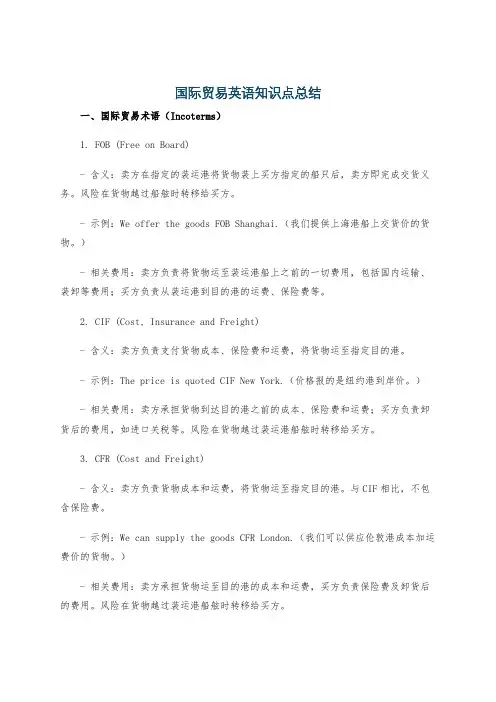
国际贸易英语知识点总结一、国际贸易术语(Incoterms)1. FOB (Free on Board)- 含义:卖方在指定的装运港将货物装上买方指定的船只后,卖方即完成交货义务。
风险在货物越过船舷时转移给买方。
- 示例:We offer the goods FOB Shanghai.(我们提供上海港船上交货价的货物。
)- 相关费用:卖方负责将货物运至装运港船上之前的一切费用,包括国内运输、装卸等费用;买方负责从装运港到目的港的运费、保险费等。
2. CIF (Cost, Insurance and Freight)- 含义:卖方负责支付货物成本、保险费和运费,将货物运至指定目的港。
- 示例:The price is quoted CIF New York.(价格报的是纽约港到岸价。
)- 相关费用:卖方承担货物到达目的港之前的成本、保险费和运费;买方负责卸货后的费用,如进口关税等。
风险在货物越过装运港船舷时转移给买方。
3. CFR (Cost and Freight)- 含义:卖方负责货物成本和运费,将货物运至指定目的港。
与CIF相比,不包含保险费。
- 示例:We can supply the goods CFR London.(我们可以供应伦敦港成本加运费价的货物。
)- 相关费用:卖方承担货物运至目的港的成本和运费,买方负责保险费及卸货后的费用。
风险在货物越过装运港船舷时转移给买方。
二、商务信函写作。
1. 信头(Letterhead)- 包含公司名称、地址、联系方式(电话、传真、电子邮箱等)。
- 例如:ABC Company.123 Main Street, New York, NY 10001.Tel: +1 - 212 - 1234567.Fax: +1 - 212 - 1234568.Email:*******************.2. 称呼(Salutation)- 如果知道对方姓名,用“Dear Mr./Ms. + 姓氏”,如“Dear Mr. Smith”;如果不知道具体姓名,可用“Dear Sir/Madam”或者“To Whom It May Concern”。
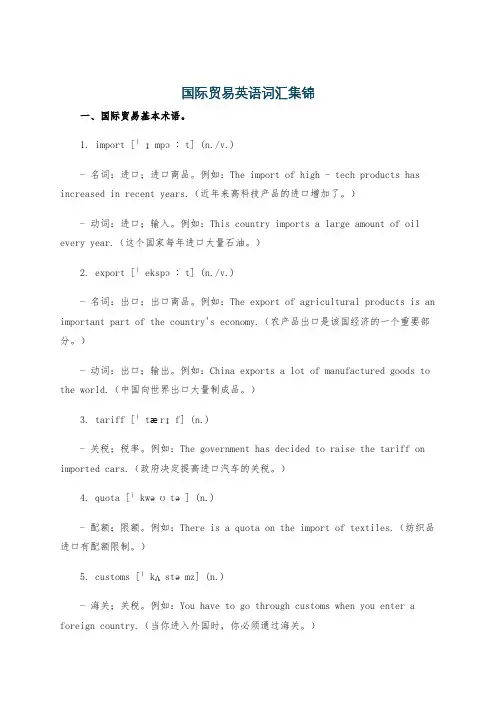
国际贸易英语词汇集锦一、国际贸易基本术语。
1. import [ˈɪmpɔːt] (n./v.)- 名词:进口;进口商品。
例如:The import of high - tech products has increased in recent years.(近年来高科技产品的进口增加了。
)- 动词:进口;输入。
例如:This country imports a large amount of oil every year.(这个国家每年进口大量石油。
)2. export [ˈekspɔːt] (n./v.)- 名词:出口;出口商品。
例如:The export of agricultural products is an important part of the country's economy.(农产品出口是该国经济的一个重要部分。
)- 动词:出口;输出。
例如:China exports a lot of manufactured goods to the world.(中国向世界出口大量制成品。
)3. tariff [ˈtærɪf] (n.)- 关税;税率。
例如:The government has decided to raise the tariff on imported cars.(政府决定提高进口汽车的关税。
)4. quota [ˈkwəʊtə] (n.)- 配额;限额。
例如:There is a quota on the import of textiles.(纺织品进口有配额限制。
)5. customs [ˈkʌstəmz] (n.)- 海关;关税。
例如:You have to go through customs when you enter a foreign country.(当你进入外国时,你必须通过海关。
)二、贸易方式相关术语。
1. wholesale [ˈhəʊlseɪl] (n./adj./v.)- 名词:批发。
外贸英语知识点
外贸英语的知识点可以涵盖以下几个方面:
1. 外贸基础知识:了解国际贸易的基本概念、国际贸易的形式和模式、进出口的基本流程和步骤等。
2. 贸易方式和交易方式:了解不同贸易方式(如进出口贸易、代理贸易、合资合作等)和交易方式(如FOB、CIF、DDP 等),熟悉各种交易方式的特点和适用范围。
3. 外贸操作流程:包括询盘、报价、谈判、签约、装运、结算等各个环节的具体操作,了解每个环节的重要事项和注意事项。
4. 国际贸易术语:熟悉国际贸易常用的英文术语,如INCOTERMS、L/C、T/T、B/L等,了解这些术语的含义和使
用方法。
5. 贸易文件和证书:了解常见的贸易文件和出口证书,如发票、装箱单、产地证书、检验证书等,知道如何填写和使用这些文件和证书。
6. 国际贸易的风险管理:了解不同的贸易风险,如信用风险、汇率风险、物流风险等,学会如何进行风险评估和管理,以减少贸易风险带来的损失。
7. 外贸谈判和沟通技巧:掌握外贸谈判和沟通的基本技巧,了解不同文化背景下的交流方式和礼仪,学会如何与国外客户建
立良好的合作关系。
8. 国际贸易政策和法规:了解国际贸易的相关法律法规和政策,如关税规定、进口限制、贸易协定等,以便在外贸业务中合规经营。
以上只是外贸英语的一些基本知识点,实际上还有很多其他的知识点需要学习和了解。
在学习外贸英语时,可以阅读相关的教材、参加培训班或课程,同时多与从事外贸工作的人交流和实践,以提高自己的外贸英语水平。
第一章Introduction1.I had to take out insurance when I bought the house. 投保2.Insurance policy保险单3.The insurance policy runs out next month.到期pound word复合词5.example sentence with a collocation搭配6.Where do you store your new vocabulary?(restore,恢复)7.on a sheet of paper8.group the new words and phrases分组9.manpower人力,劳动力manpower shortage 劳动力缺失Franchise特别经营权countersign会签(双方签字)10.in a logical sequence按有逻辑的顺序11.agenda议程表postpone延期(=put off)AGM(=annual general meeting)年度股东大会balance sheet资产负债表minutes备忘录;会议记录12.table 表格prefix前缀suffix 后缀globalize 使全球化13.cost-cutting 消减成本staff turnover员工交替(率)turnover营业额lump sum总额;一次性付款product launch产品上市mail order 邮购er friendly 为客户着想的;便于非专业客户使用的duty free 免关税的duty-bound 义不容辞的counter productive适得其反的short list 最终候选人名单short cut捷径under cut削价竞争head hunt 猎头(物色、延揽高层人物)down size 裁员15.盈利make a profit 亏本make a loss1a1.Acquire=take over2.turnover 营业额3.take on responsibility,accountable 4.bring in 5. work on/at managerial skills 6.monthly review每月评论,每月盘点7. measure progress against sth.对照……评价8.poles apart截然相反(Mr Hickey's view is poles apart from Jim O'Neill at GoldmanSachs)9.Uroda SA(或S/A,S.A.)乌诺达股份有限公司10.electric激动的,刺激的11.throw/cast new light on oldproblem 提供线索、情况,进一步了解12.small profits and quick returns薄利多销13. allocate roles to sb.分配14.point of view意见15.subsidiary子公司16.make a decision on sth.17. project team项目工作组18.Poland波兰Polish波兰的polish v.磨光Poles波兰人portion 部分19.align with与……联盟20.walk the talk说到做到21.capitalize on(synergy)利用(协同)22.foster positive attitudes 23.not a little(=very much)大量的,not a bit(=not at all)一点也不24.alternatively或者(If you do not like it, change it.Alternatively, accept it.)25.strive for excellence 追求卓越26. expatriate managers 外派经理anize courses, setout a course开设课程28. clarify procedures明确步骤、程序29.foster positive attitudes 培养积极态度30. increaseturnouts增加销售额31. company profile 公司概况;high profile高姿态,鲜明的立场32. survival course 拓展课程33.be specific to sb. 某人特有1b1. time-consuming费时2.refer to it at any time you like你随时可以拿来参考3. snail-mail 传统信件intranet内联网,企业内部网manuals指南,手册,说明书video-conferencing视频会议4.prompt快捷的,迅速的5.bilingual通两种语言的人;双语的6.understate保守地说;有意轻描淡写7.chunk大块8.idiomatic惯用的,符合语言的Idiomatic expression 惯用语,成语性词语9.When you leave a message, what should you pay attention to? 1st: be very clear;2nd: establish context(来龙去脉);3rd: make requests simple and polite;4th: give clear contact information 10.red tape 11.I’ll put you through.我帮你接过去。
国际经贸高级英语国际经贸(International Trade and Business)是指在不同国家、地区和民族之间进行的贸易和商业活动。
随着全球化进程的加速,国际经贸日渐成为世界经济发展的重要组成部分。
以下是国际经贸领域的一些重要概念及其含义。
一、自由贸易(Free Trade)自由贸易是指不设置关税、非关税壁垒、配额和补贴等障碍,允许商品和服务在国际市场上自由流通的贸易形式。
自由贸易的优势在于扩大市场、增加贸易量、降低成本、提高效益、促进技术创新和促进经济发展。
二、贸易保护主义(Trade Protectionism)贸易保护主义是指由政府设置关税、非关税壁垒和配额等措施限制进口贸易,以保护本国产业和就业的一种经济政策。
虽然贸易保护主义能够对本国产业带来一定程度的保护,但同时也会导致进口商品价格上涨、本国消费者购买力下降、国际贸易关系紧张等问题。
三、获得最惠国待遇(Most-Favored Nation Treatment)获得最惠国待遇是指在国际贸易中,一个国家给予另一个国家最好的待遇。
在贸易谈判中,通常会将这个原则纳入协议中,以保障所有国家在贸易活动中都能够获得公平和平等的待遇。
四、关税(Tariff)关税是指对进口或出口商品征收的税费。
在国际贸易中,由于各国经济发展水平和资源优势的不同,通常会对某些商品征收高额的关税,以保护本国相关产业。
但是高额的关税会限制商品的自由流通,对消费者和生产者都会产生不利的影响。
五、非关税壁垒(Non-Tariff Barrier)非关税壁垒是指除关税以外的其他形式的贸易壁垒,例如制定技术标准、认证程序、进出口许可证、产品检验检疫等措施。
非关税壁垒的常见形式包括反倾销、反补贴、贸易限制、之间征收等。
这些措施可能会对国际贸易造成额外的成本和不确定性。
六、自由贸易区(Free Trade Area)自由贸易区是指在符合自由贸易原则和规则下,两个或多个国家自愿实现商品和服务的自由流通,并取消自己之间的贸易壁垒的地区。
外贸交易知识点总结英文International trade is the exchange of goods and services between countries. It is an important aspect of the global economy and can have a significant impact on a country's economic growth and development. Here are some key points to consider when engaging in international trade:1. Trade Agreements and Tariffs- Trade agreements are formal agreements between two or more countries to facilitate and promote trade and economic cooperation. These agreements may include provisions for reducing or eliminating tariffs, quotas, and other trade barriers.- Tariffs are taxes or duties imposed on imported goods and are used to protect domestic industries and generate revenue for the government. Tariffs can have a significant impact on the cost and availability of goods in the importing country.2. Exporting and Importing- Exporting is the sale of goods and services to foreign markets, while importing is the purchase of goods and services from foreign markets. Both exporting and importing can provide opportunities for businesses to expand their customer base and increase revenue.- Exporting and importing require careful consideration of regulations, documentation, and logistics. It is important for businesses to understand the legal and logistical requirements for international trade in order to avoid potential pitfalls and ensure smooth transactions.3. Currency Exchange and Exchange Rates- Currency exchange is the conversion of one currency into another for the purpose of trade or investment. Exchange rates represent the value of one currency relative to another and can fluctuate based on a variety of factors, including economic conditions and geopolitical events.- Fluctuations in exchange rates can have a significant impact on the cost and profitability of international trade. Businesses engaged in international trade should monitor exchange rates and consider strategies to manage currency risk, such as hedging and forward contracts.4. Trade Finance- Trade finance refers to the financial instruments and products that facilitate international trade, such as letters of credit, trade finance loans, and export credit insurance. These financial tools can help businesses mitigate the risks associated with international trade and access the capital needed to support their trade activities.- Trade finance can be complex and requires a thorough understanding of international trade regulations and financial practices. Businesses should work with experienced financial and legal professionals to navigate the complexities of trade finance and ensure compliance with applicable laws and regulations.5. Trade Compliance and Documentation- International trade is subject to a variety of regulations and documentation requirements, including customs declarations, import and export licenses, and compliance with trade sanctions and embargoes. Non-compliance with these requirements can result in significant penalties and legal consequences.- Businesses engaged in international trade should have robust compliance programs in place to ensure adherence to applicable laws and regulations. This may include engaging with customs brokers, legal counsel, and trade compliance experts to navigate the complexities of international trade regulations and documentation.6. Market Research and Cultural Considerations- Before entering a new international market, businesses should conduct thorough market research to understand the local demand, competitive landscape, and cultural considerations. Cultural differences can have a significant impact on business practices, communication, and consumer behavior.- Businesses should be mindful of cultural nuances and adapt their marketing and business strategies accordingly to effectively engage with customers in international markets. This may include tailoring product offerings, marketing messaging, and business practices to align with local customs and preferences.7. Risk Management and Insurance- International trade involves various risks, including political, economic, and commercial risks. Businesses should consider strategies to mitigate these risks, such as obtaining trade credit insurance, political risk insurance, and commercial risk insurance.- Effective risk management is critical to the success of international trade operations. Businesses should assess and quantify their risk exposure and implement strategies to mitigate and transfer risk. This may include working with insurance providers, legal counsel, and risk management experts to develop a comprehensive risk management strategy.8. Intellectual Property Protection- Intellectual property rights, such as patents, trademarks, and copyrights, are essential for protecting innovation and creativity in international trade. Businesses should understand the importance of intellectual property protection and take steps to safeguard their intellectual assets in international markets.- Intellectual property infringement is a significant risk in international trade, particularly in regions with weak intellectual property enforcement. Businesses should take proactive measures to protect their intellectual property, including obtaining patents and trademarks, enforcing their rights through legal channels, and working with local counsel to navigate intellectual property regulations in foreign markets.9. Ethical and Social Responsibility- Businesses engaged in international trade should uphold ethical and social responsibility standards throughout their operations. This may include adhering to fair labor practices, sustainability initiatives, and responsible sourcing and manufacturing practices.- Ethical and social responsibility considerations are increasingly important in international trade, as consumers and stakeholders demand transparency and accountability from businesses. Companies should implement ethical and socially responsible practices in their international operations and communicate these efforts to their stakeholders.In conclusion, international trade presents significant opportunities for businesses to expand their reach and access new markets. However, navigating the complexities of international trade requires careful consideration of trade regulations, financial practices, risk management, and ethical considerations. Businesses should work with experienced professionals and stakeholders to develop a comprehensive international trade strategy and ensure compliance with applicable laws and regulations. By approaching international trade with a thorough understanding of its complexities and risks, businesses can maximize the benefits of global trade and position themselves for success in the international marketplace.。
国际经济与贸易重点(全英)一、名词解释Classical International Trade Theory (古典贸易理论):The way to earn precious metals was to export more goods and services than it imported.The resulting export surplus would then be settled by an inflow of bullion, or precious metals, primarily gold and silver. The more gold and silver a nation had, the richer and more powerful it was. Thus,the government had to do all in its power to stimulate the nation’s exports and discourage and restrict imports. However, since all nations could not simultaneously have an export surplus and the amount of gold and silver was fixed at any particular point in time, one nation could gain only at the expense of other nations.Therefore, trade was a zero-sum gameabsolute advantage(绝对优势):If one nation is more efficient than (or has an absolute advantage over) another nation in the production of one commodity, the nation has absolute advantage in that commodity.law of comparative advantage (比较优势理论):The law of comparative advantage is one of the most important and unchallenged laws of economics, with many practical applications. How can we judge comparative advantage of one nation? Usually by 3 ways:relative labor productivity relative cost of manufacture opportunity costGains from trade(贸易所得):in economics refers to net benefits to agents from allowing an increase in voluntary trading with each other. In technical terms, it is the increase of consumer surplus[1] plus producer surplus[2] from lower tariffs[3] or otherwise liberalizing trade。
一、英译domestic business 国内贸易ecomomic globalisation 经济全球化host country 东道主国家intellectual property 知识产权non-tariff barriers 非关税贸易壁垒portfolio investment 证券certificate deposit大额存单management contract 管理合同 contract manufacturing 承包生产Turkey project 交钥匙工程wasted interests 既得利益 BOBOT(build,operate,transfer)建设personal advancement个人晋升service industry 服务产业National product 国民产值per capita GDP 人均国内生产总值staple goods大路货 organization of economic and development 经济合作commonwealth of idpendent States 独立国家联合体 creditor country 债权国 ASEAN东南亚国家联盟 PPP(pu organization of petroleum exporting countries(OPEC)north 石油输出国组织 American free trade agre economic integration 经济一体化 common market 共同市场 sovereign state 主权国家 political entity day to day running 日常管理 the parent MNE 多国公司母公司 National economic welfare 国self-sufficient 自给自足的 farm produce 农产品 the endowments of Nature 自然禀赋 peproduction capability 生产能力 consumption preference 消费偏好 cost advantage 成本优势customs clearance 结关 EDI 电子数据交换 incoterms 国际贸易术语解释通则 destination potrade fair 交易会 international trunk call 国际长途 the business line 业务范围 forceleverage 杠杆作用 trade credit account 贸易信贷往来账户 centrally planned economy 中央计划经济 com financial market 金融市场 vertically related 纵向关联的 procession trade 加工贸易 leasing trade 租to open account 开立账户 consignment transaction 寄售交易 a usance draft 远期汇票 documentary colle periodic payments 分期付款 clean draft 光票 insurance policy 保险单 documents against acceptance 承impeccable documents 正确无误单据 correspondent bank 往来行 advising bank 通知行 confirming bank 保credit-worthiness 信誉 opening bank 开证行 the paying bank 付款行 the negotitation 议付行 partial irrevocable credit 不可撤销的信用证 sight credit 及期信用证 deferred payment credit 推迟付款信用证face value 面值 net proceeds 净值 discount charges 贴现费 non-trade settlement 非贸易结算 revolving consignor 托运人 consular invoice 领事发票 notify party 被通知人 credit terms 信用证条款 terms of p time lag 时差 claim on goods 对货物的索赔 all risks 一切险 premium 保险费 insurer 保险人 common poo settlement of a claim 理赔 freight forwarder 货运代理行 utmost good faith 最大诚信原则 valued polic exchange rate 汇率 balance of payment 收支平衡 directo quote 直接标价 buying rate 买入价 financial gold standard 金本位制 gold par value 金平价 interaction of supply and demand 供求关系变化 foreig fixed exchange rate 固定汇率 par value 平价 the international bank of reconstruction and developm reserve currency 储备货币 the special drawing right 特别提款权 favorable balance of payment 贸易顺financial resources 资金 retained capital 预留资金 grace period 宽限期、优惠期 a specialized mand the international monetary fund 国际货币基金组织 IDA the international development association 国际private sector 私营经济 tax holiday 免税期 Greenfield strategy 绿地战略 customer mobility 客户流动 VER,voluntary export restriction 自动出口限制 after-sale service 售后服务 distribution network 销售government stock 政府债券 market maker 股票经营商 standing committee 常务委员会 underlying securit long-term capital 长期资本 fixed interest stocks 定息股 SEAQ(stock,exchange,automated,quotatio the domestic equity market 国内普通股市场 the gilt-edged market 金边证券市场 the trade options mark listed market 过牌证券交易市场 VAT(value added tax)增值税 institutional investors 事业机构投资商a uniform tariff system 统一关税体系 the optional use of the resources 资源的最佳利用 a provisional non-discriminate principle 非歧视原则 export subsidy 出口补贴 escape clause 豁免条款 a new economic UNGA(united nations general assembly)联合国大会 principle of a differential treatment 差别待遇原trade and development board 贸易发展理事会 income distribution 收入分配 infrastructure基础设施 for free trade area 自由贸易区 European union 欧盟 Asia-Pacific economic co-operation(OPEC)亚太经合组shareholder股东 manufacturing facilities 生产设施 international economic environment 国际经济环境 productive resources 生产资源 ready markets 现成的市场 continued survival 持续生存 the distributi the theory of comparative advantage 比较利益理论 the multual beneficial trade 互利贸易 the reserves CIF 肩负运费保险费货架 trade terms 贸易条款 amendment to the letter of credit 修改信用证 container bill of lading 提单 quotation 报价to make an offer 发盘 the validity periodi有效期 mode of payment付bilateral agreement双边协议 barter易货贸易 vertical combination垂直合并、纵向组合 hyperinflation极go bankrupt 破产 lead to loss of business 导致损失业务 open account 记账交易 commercial letter of c confirmed credit保兑信用证 usance credit远期信用证 face value票面价值 capital turnover资金周转 con port of shipment 装运港 commercial invoice商业发票 customs invoice海关发票 consular invoice 领事发 net weight 净重 Gross weight 毛重 primitive mode of production原始的生产方式 the free movement of commercial intercourse 商业交流 margin保证金 investment in stocks股票投资 cargo insurance货物保险 vhandmaiden 起服务作用的事物 subrogation代位追偿 the doctrine of proximate近因原则 opefreight fowarder 运输代理行 utmost good faith 最大诚信(原则)life or personal accident insurance人world capital market世界资本市场 the cost of borrowing(lending)借贷成本 net earning净收入 equity IFC,international finance corporation 国际金融公司 official reserves 官方储备 voting power 投票权 stand by arrangement 备用(贷款)安排 mid-term loans 中期贷款 joint venture合资公司 acquisition并购sales volume 销售量 existing debts 现存的债务 backward equipment陈旧的设备 out-moded management pro the issue and trading of securities证券的发行与交易 a consultative mechanism协商机制 bilateral nemultilateral trade system多边贸易体系 the general agreement on tariff and trade关税及贸易总协定 technology transfer技术转让 commodity agreement商品协议 preferential优惠关税 the new internation compensatory measures补偿措施 collaboration 合作二、barrier——things that prevents or controls progress or movement;hindrancelicence——official document showing that permission has been given to own,use or do something;pe patent——the right to be the only maker and seller of articleprofit——money left over as earning after all expences have been paidfranchise——formal permission to sell a company‘s goods or services in a particular area potentia——what sb. Or sth. Is capable ofclue——fact,idea,etc. that suggest a possible answer to a problemspur——to urge or encourageproximity——nearnesshemisphere——half a sphere;half the earthwitness——be present at and see;give evidence ofautonomy——self-government,freemdomlandmark——event,Discovery,change,etc. that marks a stage or turning-pointveto——right to reject or forbid somethingcommissioner——member of a commission,sep. one with particular dutiesacclaim——welcome with shouts of approval;applaud loudlyadverse——unfavorable;contrary or hostilecontroversial——likely to cause controversypredominance——superiority in strength,numbers,etc.intervene——interfere so as to prevent sth. Or change the resultdistribution——the movement of goods and materials from place to placedefine——state precisely the meeaning ofefficiency——competency in performancescarce——insufficient in number or amount to meet a demand readilyendowment——money;property,etc. given to provide an incomeperishable——esp.of food quickly or easy going badcoincide——(of ideas,etc.)be in harmony or agreementrefund——pay back money to sbconcession——conceding,that which is conceded,esp. after discussion,a difference ofimpose——lay or place tax,duty,etc. onclimate——a prevailing attitude,atmosphere,or conditionsdegenerate——deterioraterespective——belonging to each of those in questionsinterpretation——explanationrevise——changebinding——compulsoryconfirmation——approvalto set forth——to detailclaim——a demand for something that is legally duerefusal——turning downdrastically——violentlysophisticated——complex,complicated,intricatephenomenon——a fact ,occurrence,or circumstance observed or observable concurrently——simultaneously,meanwhile,at the same timeliterally——in accordance with the strict meaning of the Word or textdebtor——a person who owes moneydraft——an unconditional order to someone to pay a sun of moneyfluctuation——irregular movement of(prices,exchange rates etc.)ban——prohibit,forbiddrawee——the person to whom a draft is drawncredit-worthiness——being believed or accepted by others as reliable in making paymentapplicant of an L/C——the importer that goes to a bank for the establishment of an L/C beneficiary——the company that can make use of an L/C to get paid for its export discrepancy——difference,absence of agreementreimburse——pay back to somebody for the expense he has spentimpeccable——faultlessinsolvent——unable to pay debtsmaturity——becoming duemiddle man——trader through whom goods pass between the producer and the consumersustain——suffercertificate of inspection——a document certifying that merchandise was in good condition at the ti shiping advice——a written notice from the exporter to the importer after shipment for taking deli certificate of weight——a document stating the weight of a shopmentconformity——action,behavior,in agreement with what is usually accepted or requiredcarrier——a personnel or organizations whose business is carrying goods from one place to another primitive——being the first or earliest of the kindintercours——dealings or communications between individuals or between countries entrepreneur——a person who organize and manages an enterpriselimelight——a position at the center of public attentionshackle——a fastening or coupling devicecompensation——sth. Given or received as an equivalent for losssurvey——to know or study in a comprehensive waycircumstance——existing conditions or state of affairsclient——customerunderwriter——insurance company,the insurercrucial——vital or decisive importanceplatinum——gray,untarnishable metal used for jewellerynegligent——careless and differencediminish——to make or become smaller or lessbrand-new——quite new,as if freshly stamped with a brandpeg——to keep fixed or unchangedredeem——to repay or pay off,esp.loan stock,debentures and preference shares or stock settlement——the act of paying a bill,debt,charge,etc.exchange rate——the price at which one currency can be exchanged for another currency fluctuation——upward and downward movements in the economic systemguarantee——a formal promise or assurancecharter——written description of an organization's functionmitigation——the act of making less seriousto sponsor——to put up the money forconvention——a formal agreementacquisition——company expansion through the purchase of other businessrebate——reducetax holiday——a period of time which tax is not leviedreturn——the gain from an investment,either as income or yield or as profit on the sale of the in access——a way by which a place,esp. property of other businessstatue——a law enacted by the action of the legislaturepractitioner——someone involved in a usually skilled job or activitysophisticated——highly developed and complexstandard——of recognized and permanent valueexpertise——expert skill,knowledge or judgmentdraft——preliminary versionpreamble——opening statementunanimous——in complete agreementoptimal——best or most favourablebiennial——recurring every two yaersperennial insistence——repeatedly demandingexploitation——taking advantage of others for one's own benefitto adapt to——to adjust tocooperation——working togethercolony——a country controlled politically by another powerful country三、英对expertise——expert knowledge or skilljoint venture——a commercial undertaking by two or more people,differing from a partnership in th partnership——a contractual relationship between two or more people in a joint enterprise,who agr distribution——a person who sends goods from those who uuse themportfolio——the entire collection of investment in the form of stocks,bonds,or certificate of de assess——to judge an amount or valuespur——to urge or encourageinfrastructure——large-scale public service,such as water and power supplies,road,rail and radi PPP——purchasing power parityconsumerism——considerable desire to make purchase for consumptionliberalize——of trade ,the act of government in lifting control over imports and expo detour——route that void a blocked road;deviationerode——wear away ,eat intointegration——combine into a wholeenvisage——pictures in the mind sa a future possibility;imageaffliate MNC——it is associated or controlled by its parent MNVwithout losing its own identity profit——the money gained in a business deal,especially the difference between the amount earned a inflation——a general rise in prices within an economy,accompanied by a reduction of the value of revenue——the money received by a firm from selling its output of goods or servises or money earne host country——in international trade ,the country in which a multinational corporation is active,international trade——the exchange of goods and services between countries through exports and imp absolute advantage——an advantage possessed by a country engaged in international trade when,usin specialization——to restrict one's economic activities to certain particular fields intuitive——relating to the power of the immediate understanding of something without reasoning or capital——the contribution to productive activity made by investment in physical capital and in hudemand——the desire of consumers to obtain goods and serviceseconomies of scale——the long run reduction in average costs that occurs as scale of the firm's ou cost——the amount of money paid a charged for goods or servicetariff——a form of tax that is levied on imports。
Lesson11.International trade:can be defined as the exchange of goods and services produced in one country with those produced in another.2.International specialization:one country producing more of a commodity than it uses itself and selling the remainder to other countries.3.The theory of comparative advantage:holds that even if a country is less efficient than ano ther in the production of both commodities,i.e.it has absolute disadvantage in producing bot h commodities,there is still a basis for mutually beneficialtrade.4.国际专业化:international specialization绝对利益:absolute advantage比较利益:comparative advantage5.rich in advantage over point on across borders6.Translation:(1)在复杂的经济世界中,没有一个国家可以完全自给自足。
In the complex economic world,no country can be completely self-sufficient.(2)随着制造业和技术的发展,出现了另一个刺激贸易的因素,即国际专业化。
With the development of manufacturing and technology,there arose another incentive for tra de,i.e.internationalspecialization.(3)按照比较利益学说,两个贸易伙伴均可从贸易中得到好处。
According to the theory of comparative advantage,both trade partners can benefit from trade.(4)比较利益并不是一个静止的概念,一个国家可以通过自己的行动发展某种特定的比较利益。
Comparative advantage is not a static concept;a country may develop a particular comparati ve advantage through its own actions.(5)比较利益理论已成为现代国际贸易思想的基石。
The idea of comparative advantage has become the cornerstone of modern thinking on intern ational trade.Lesson21.Economies of scale:that is,the cost advantages of large-scale production.2.Tariff barriers:are the most common form of trade restriction.3.A tariff:is a tax levied on a commodity when it crosses the boundary of a customs area wh ich usually coincides with the area of a country.4.A customs union:a customs area extending beyond national boundaries to include two or more independent nations iscalled a customs union.5.Import duties:are tariffs levied on goods entering an area.6.Export duties:are taxes levied on goods leaving an area.7.Drawback:refers to duties paid on imported goods that are refunded if the goods are reexp orted.8.Most-favored-nation(MFN)treatment:refers to a tariff treatment under which a country is required to exte nd to all signatories any tariff concessions granted to any participating country.9.Quotas or quantitative restrictions:are the most common form of non-tariff barriers.A quota limits the imports or exports of a commodity during a given period of time.10.需求结构:patterns of demand生产能力:production capabilities消费爱好:consumption preference规模经济:economies of scale成本优势:cost advantage大规模生产:large-scale production关税和配额:tariffs and quotas外汇:foreign exchange革新或款式:innovation or style移民汇款:immigrant remittance11.capability at/in cost for/of at reasonable costs levied ontake into account without reference to(不针对)make efforts toengage in12.Translation:(1)一件商品的成本会因生产规模扩大而减少。
The cost of product will decrease with the expansion of production scale.(2)在实际中,即使完全的专业化在经济上有利,也可能永远不会发生。
In reality,complete specialization may never take place even though it is economically advan tageous.(3)配额或者说数量限制是最常见的关税壁垒。
Quotas or quantitative restrictions are the most common form of non-tariff barriers.(4)有形贸易指货物的进出口贸易,而无形贸易涉及的是国家间的劳务交换。
The visible trade is the import and export of goods,and the invisible trade is the exchange of services between countries.(5)国家从事的贸易种类是多样的、复杂的,往往是有形贸易和无形贸易的混合。
The kinds of trade nations engage in are varied and complex,often a mixture of visible and i nvisible trade.Lesson31.Consignment transaction:this means the exporter has to send his goods abroad and will no t get payment until thegoods are sold.If not sold,the goods can be shipped back.2.The draft:also referred to as the bill of exchange,is an unconditional order to a bank or a c ustomer to pay a sum ofmoney to someone on demand or at a fixed time in the future.3.Sight draft:calls for immediate payment on presentation to the drawee.ance draft:is payable at a later date,e.g.30,45,60or90days after sight or date.5.Documentary draft:the draft is accompanied by the relevant documents such as the bill of lading,the invoice,theinsurance policy etc.6.Documents against payment(D/P):documents will not be released to the importer until pa yment is effected.7.D/P at sight:requires immediate payment by the importer to get hold of the documents.8.D/P after sight:gives the importer a certain period after presentation of the documents,but documents are not released to him until he actually pays for the merchandise.9.Documents against acceptance(D/A):documents are handed over to the importer upon his acceptance of the bill ofexchange drawn by the exporter.Payment will not be made until a later date.D/A is always a fter sight.10.外汇管制:foreign exchange control预付现金:cash in advance记帐贸易:open account破产:go bankrupt11.add up to(amount to)have/gain control over part with(分手)enter into on demand(立即)hand over to(交给)push the sale(促销)tie up money(占压资金)make/effect paymentopen/issue/establish L/C with bank in one"s favor(以谁为受益人)12.Translation:(1)在国际贸易中进出口双方都面临风险,因为总存在对方不履约可能。